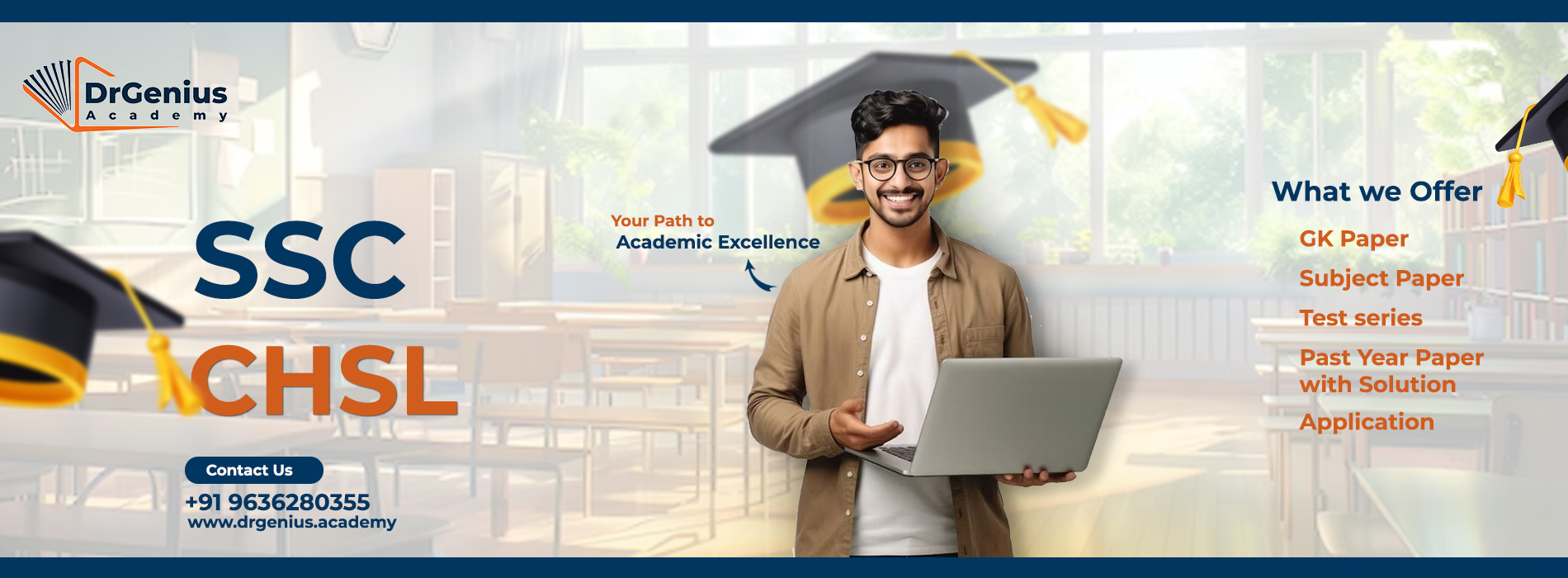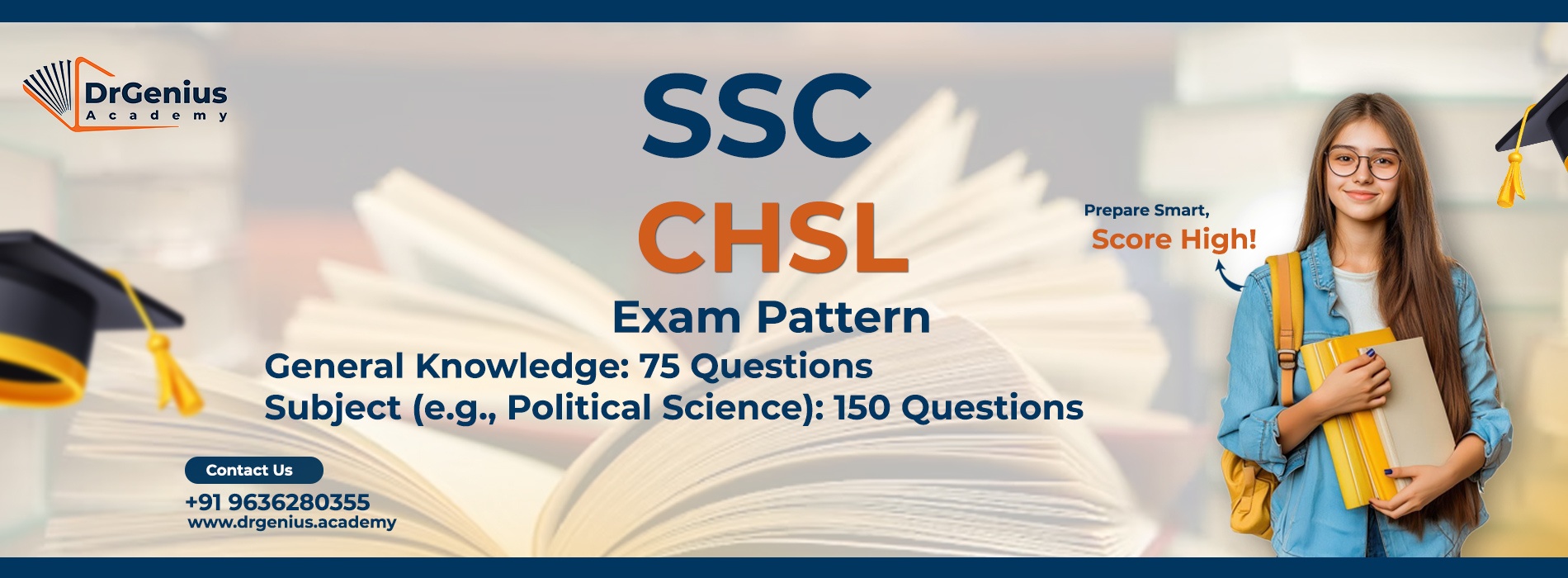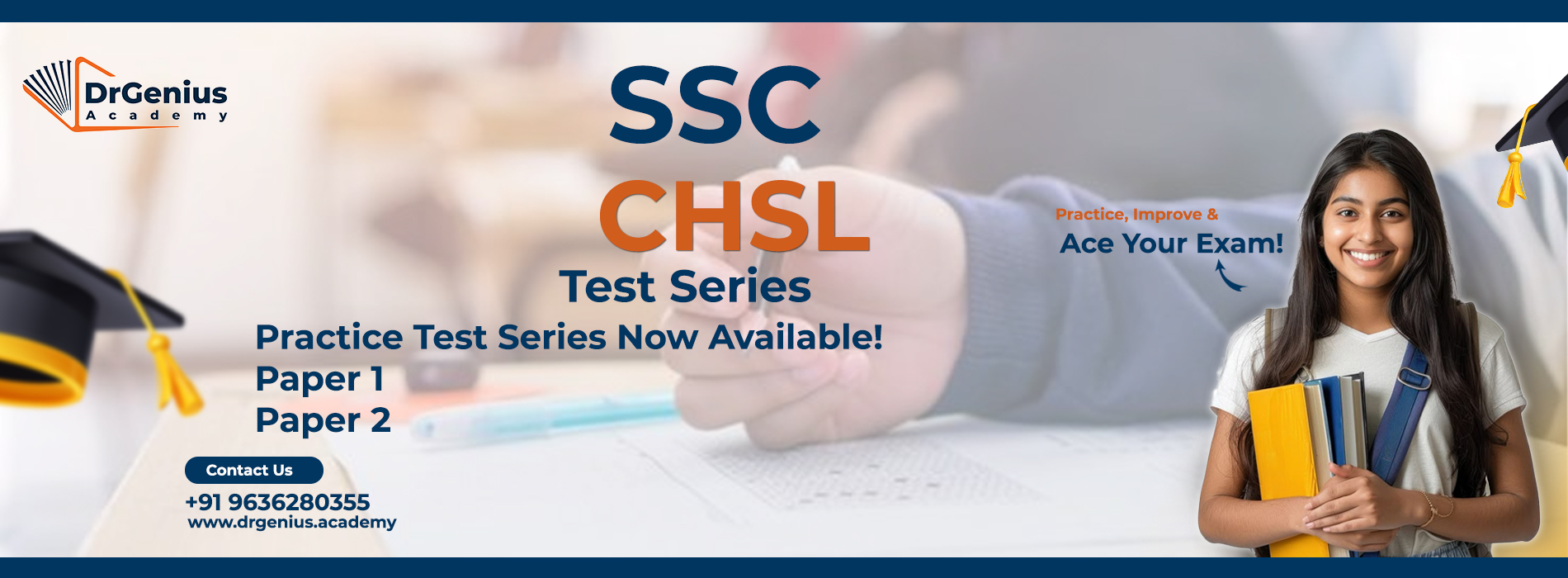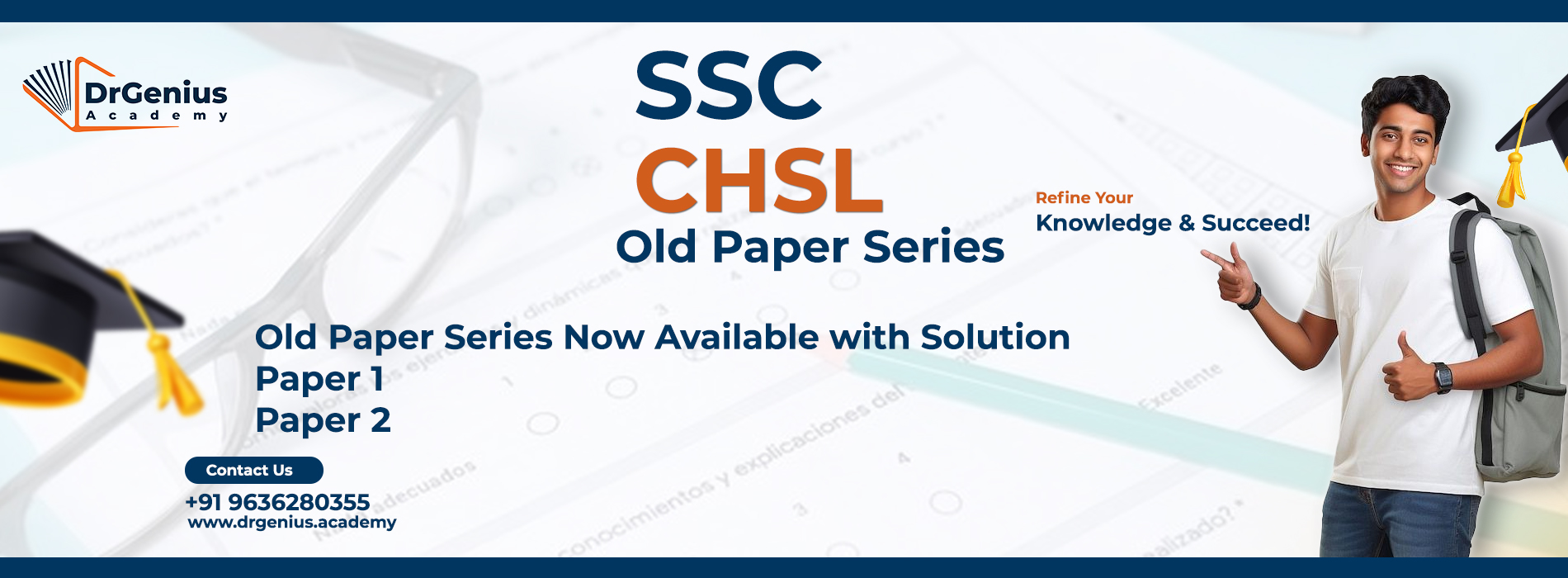SSC CHSL Exam Online Preparation – Syllabus, Tips & Study Plan




SSC CHSL
- Notification
- Schems (Pattern)
- Topic
- Syllabus
- Old Paper
- Faculties
- Course
- Test Series
- Fees Structure
- Admit Card
- Instruction For Candidate
- Answer Key
- Cut Off marks
- Result
PATTERN FOR EXAM
Scheme of Examination:
The Computer Based Examination will be conducted in two tiers:
• Tier-I
• Tier-II
Scheme of Tier-I Examination:
| Tier | Part | Subject (Not in sequence) | Number of Questions/ Maximum Marks | Time Duration (For all four Parts) |
|---|---|---|---|---|
| I | I | English Language (Basic Knowledge) | 25/ 50 | 60 Minutes (80 Minutes for candidates eligible for scribe) |
| I | II | General Intelligence | 25/ 50 | |
| I | III | Quantitative Aptitude (Basic Arithmetic Skill) | 25/ 50 | |
| I | IV | General Awareness | 25/ 50 |
• The Tier-I Examination will consist of Objective Type, Multiple choice questions only. The questions will be set in English, Hindi and any language opted by the candidate in the application form.
• There will be negative marking of 0.50 marks for each wrong answer.
Scheme of Tier-II Examination:
| Tier | Session | Subject | Number of Questions | Maximum Marks | Time allowed |
|---|---|---|---|---|---|
| II | Session – I (2 hours and 15 minutes) |
Section-I: Module-I: Mathematical Abilities Module-II: Reasoning and General Intelligence |
30 + 30 (Total = 60) |
60 × 3 = 180 | 1 hour (for each section) (1 hour and 20 minutes for the candidates eligible for scribe) |
| Section-II: Module-I: English Language and Comprehension Module-II: General Awareness |
40 + 20 (Total = 60) |
60 × 3 = 180 | 1 hour (for each section) (1 hour and 20 minutes for the candidates eligible for scribe) |
||
| Section-III: Module-I: Computer Knowledge Module |
15 | 15 × 3 = 45 | 15 Minutes (20 minutes for the candidates eligible for scribe) |
||
| II | Session – II | Section-III: Module-II: Skill Test / Typing Test Module |
Part A: Skill Test for DEOs in Department/ Ministry |
Part A: 15 Minutes (20 minutes for the candidates eligible for scribe) |
|
| Part B: Skill Test for DEOs except in Department/ Ministry- | Part B: 15 Minutes (20 minutes for the candidates eligible for scribe)< | ||||
| Part C: Typing Test for LDC/ JSA- | Part C: 10 Minutes (15 minutes for the candidates eligible for scribe)< |
1. Tier-II will be conducted in two sessions - Session –I & Session-II, on same day. Session-I will include conducting of Section-I, Section-II and Module-I of Section-III. Session-II will include conducting of Module-II of Section-III.
2. It will be mandatory for the candidates to qualify all the sections of Tier-II.
3. Tier-II will consist of Objective Type, Multiple choice questions, except for Module-II of Section-III. The questions will be set in English, Hindi and any language opted by the candidate in the application form, Module-II (i.e. English Language and Comprehension module) in Section-II.
4. There will be negative marking of 1 mark for each wrong answer in Section-I, Section-II and Module-I of Section-III.
5. Module-I of Section-III i.e. Computer Knowledge Test is mandatory but qualifying in nature.
6. Module-II of Section-III i.e. Skill Test/ Typing Test:
7. Module-II of Section-III will include conducting of Skill Test/ Typing Test in Session-II on the same day.
8. Skill Test/ Typing Test will be evaluated as per the evaluation guidelines available on the website of the Commission.
9. Errors in the Skill Test will be calculated up to 2 decimal places.
SSC – CHSL
SYLLABU
Tier-I:
English Language: Spot the Error, Fill in the Blanks, Synonyms/ Homonyms, Antonyms, Spellings/ Detecting mis-spelt words, Idioms & Phrases, One word substitution, Improvement of Sentences, Active/ Passive Voice of Verbs, Conversion into Direct/ Indirect narration, Shuffling of Sentence parts, Shuffling of Sentences in a passage, Cloze Passage, Comprehension Passage.
General Intelligence: It would include questions of both verbal and non-verbal type. The test will include questions on Semantic Analogy, Symbolic operations, Symbolic/ Number Analogy, Trends, Figural Analogy, Space Orientation, Semantic Classification, Venn Diagrams, Symbolic/ Number Classification, Drawing inferences, Figural Classification, Punched hole/ pattern-folding & unfolding, Semantic Series, Figural Pattern-folding and Page 19 of 87 completion, Number Series, Embedded figures, Figural Series, Critical Thinking, Problem Solving, Emotional Intelligence, Word Building, Social Intelligence, Coding and de-coding, Numerical operations, Other sub-topics, if any.
Quantitative Aptitude:- Number Systems: Computation of Whole Number, Decimal and Fractions, Relationship between numbers.
- Fundamental arithmetical operations: Percentages, Ratio and Proportion, Square roots, Averages, Interest (Simple and Compound), Profit and Loss, Discount, Partnership Business, Mixture and Allegation, Time and distance, Time and work.
- Algebra: Basic algebraic identities of School Algebra and Elementary surds (simple problems) and Graphs of Linear Equations.
- Geometry: Familiarity with elementary geometric figures and facts: Triangle and its various kinds of centres, Congruence and similarity of triangles, Circle and its chords, tangents, angles subtended by chords of a circle, common tangents to two or more circles.
- Mensuration: Triangle, Quadrilaterals, Regular Polygons, Circle, Right Prism, Right Circular Cone, Right Circular Cylinder, Sphere, Hemispheres, Rectangular Parallelepiped, Regular Right Pyramid with triangular or square Base.
- Trigonometry: Trigonometry, Trigonometric ratios, Complementary angles, Height and distances (simple problems only) Standard Identities like sin2? + Cos2?=1 etc.,
- Statistical Charts: Use of Tables and Graphs: Histogram, Frequency polygon, Bar-diagram, Pie-chart.
General Awareness: Questions are designed to test the candidate‟s general awareness of the environment around him and its application to society. Questions are also designed to test knowledge of current events and of such matters of everyday observation and experience in their scientific aspect as may be expected of an educated person. The test will also include questions relating to India and its neighboring countries especially pertaining to History, Culture, Geography, Economic Scene, General policy and scientific research.
NOTE : For VH candidates of 40% and above visual disability, there will be no component of Maps / Graphs / Diagrams / Statistical Data in the General Intelligence and Quantitative Aptitude parts.
SSC – CHSL
SYLLABU
Tier-I:
अंग्रेजी भाषा : त्रुटि खोजें, रिक्त स्थान भरें, समानार्थी/समानार्थी, विलोम, वर्तनी/गलत वर्तनी वाले शब्दों का पता लगाना, मुहावरे और वाक्यांश, एक शब्द प्रतिस्थापन, वाक्यों में सुधार, क्रियाओं की सक्रिय/निष्क्रिय आवाज़, प्रत्यक्ष/अप्रत्यक्ष कथन में रूपांतरण, वाक्य के भागों को फेरबदल करना, गद्यांश में वाक्यों को फेरबदल करना, क्लोज पैसेज, समझ वाला गद्यांश।
सामान्य बुद्धि: इसमें मौखिक और गैर-मौखिक दोनों प्रकार के प्रश्न शामिल होंगे। परीक्षण में अर्थगत सादृश्य, प्रतीकात्मक संक्रियाएँ, प्रतीकात्मक/संख्या सादृश्य, रुझान, आकृतिगत सादृश्य, स्थान अभिविन्यास, अर्थगत वर्गीकरण, वेन आरेख, प्रतीकात्मक/संख्या वर्गीकरण, निष्कर्ष निकालना, आकृतिगत वर्गीकरण, छिद्रित छेद/पैटर्न-फोल्डिंग और अनफोल्डिंग, अर्थगत श्रृंखला, आकृतिगत पैटर्न-फोल्डिंग और पूर्णता, संख्या श्रृंखला, अंतर्निहित आकृतियाँ, आकृतिगत श्रृंखला, आलोचनात्मक सोच, समस्या समाधान, भावनात्मक बुद्धिमत्ता, शब्द निर्माण, सामाजिक बुद्धिमत्ता, कोडिंग और डी-कोडिंग, संख्यात्मक संक्रियाएँ, अन्य उप-विषय, यदि कोई हो, पर प्रश्न शामिल होंगे।
मात्रात्मक योग्यता:- संख्या प्रणाली: पूर्ण संख्या, दशमलव और अंशों की गणना, संख्याओं के बीच संबंध।
- मौलिक अंकगणितीय संक्रियाएँ: प्रतिशत, अनुपात और समानुपात, वर्गमूल, औसत, ब्याज (सरल और मिश्रित), लाभ और हानि, छूट, साझेदारी व्यवसाय, मिश्रण और आरोप, समय और दूरी, समय और कार्य।
- बीजगणित: स्कूल बीजगणित और प्राथमिक करणी (सरल समस्याएँ) की मूल बीजगणितीय पहचान और रैखिक समीकरणों के रेखांकन।
- ज्यामिति : प्राथमिक ज्यामितीय आकृतियों और तथ्यों से परिचित होना: त्रिभुज और इसके विभिन्न प्रकार के केंद्र, त्रिभुजों की सर्वांगसमता और समानता, वृत्त और इसकी जीवाएँ, स्पर्श रेखाएँ, वृत्त की जीवाओं द्वारा बनाए गए कोण, दो या अधिक वृत्तों की उभयनिष्ठ स्पर्श रेखाएँ।
- माप : त्रिभुज, चतुर्भुज, नियमित बहुभुज, वृत्त, समकोण प्रिज्म, समकोण वृत्तीय शंकु, समकोण वृत्तीय बेलन, गोला, गोलार्ध, आयताकार समांतर चतुर्भुज, त्रिभुजाकार या वर्गाकार आधार वाला नियमित समकोण पिरामिड।
- त्रिकोणमिति : त्रिकोणमिति, त्रिकोणमितीय अनुपात, पूरक कोण, ऊँचाई और दूरियाँ (केवल सरल समस्याएँ) मानक पहचान जैसे sin2? + Cos2?=1 आदि।
- सांख्यिकीय चार्ट : तालिकाओं और ग्राफ़ का उपयोग: हिस्टोग्राम, आवृत्ति बहुभुज, बार-आरेख, पाई-चार्ट।
सामान्य जागरूकता : प्रश्न उम्मीदवार की अपने आस-पास के वातावरण और समाज में इसके अनुप्रयोग के बारे में सामान्य जागरूकता का परीक्षण करने के लिए डिज़ाइन किए गए हैं। प्रश्न वर्तमान घटनाओं और रोज़मर्रा के अवलोकन और अनुभव के ऐसे मामलों के वैज्ञानिक पहलू के ज्ञान का परीक्षण करने के लिए भी डिज़ाइन किए गए हैं, जैसा कि एक शिक्षित व्यक्ति से अपेक्षित हो सकता है। परीक्षण में भारत और उसके पड़ोसी देशों से संबंधित प्रश्न भी शामिल होंगे, विशेष रूप से इतिहास, संस्कृति, भूगोल, आर्थिक परिदृश्य, सामान्य नीति और वैज्ञानिक अनुसंधान से संबंधित।
नोट : 40% और उससे अधिक दृश्य विकलांगता वाले वीएच उम्मीदवारों के लिए, सामान्य बुद्धिमत्ता और मात्रात्मक योग्यता भाग में मानचित्र / ग्राफ / आरेख / सांख्यिकीय डेटा का कोई घटक नहीं होगा।
Tier-II:
Module-I of Session-I
Mathematical Abilities
Number Systems: Computation of Whole Number, Decimal and Fractions, Relationship between numbers.
Fundamental arithmetical operations: Percentages, Ratio and Proportion, Square roots, Averages, Interest (Simple and Compound), Profit and Loss, Discount, Partnership Business, Mixture and Alligation, Time and distance, Time and work.
Algebra : Basic algebraic identities of School Algebra and Elementary surds (simple problems) and Graphs of Linear Equations. Page 20 of 87
Geometry : Familiarity with elementary geometric figures and facts: Triangle and its various kinds of centres, Congruence and similarity of triangles, Circle and its chords, tangents, angles subtended by chords of a circle, common tangents to two or more circles.
Mensuration : Triangle, Quadrilaterals, Regular Polygons, Circle, Right Prism, Right Circular Cone, Right Circular Cylinder, Sphere, Hemispheres, Rectangular Parallelepiped, Regular Right Pyramid with triangular or square Base.
Trigonometry : Trigonometry, Trigonometric ratios, Complementary angles, Height and distances (simple problems only) Standard Identities like sin2? + Cos2?=1 etc.
Statistics and probability : Use of Tables and Graphs: Histogram, Frequency polygon, Bar-diagram, Pie-chart; Measures of central tendency: mean, median, mode, standard deviation; calculation of simple probabilities.
Tier-II:
Module-I of Session-I
गणितीय योग्यताएँ
संख्या प्रणाली: पूर्ण संख्या, दशमलव और अंशों की गणना, संख्याओं के बीच संबंध।
मूलभूत अंकगणितीय संक्रियाएँ: प्रतिशत, अनुपात और समानुपात, वर्गमूल, औसत, ब्याज (सरल और मिश्रित), लाभ और हानि, छूट, साझेदारी व्यवसाय, मिश्रण और मिश्रण, समय और दूरी, समय और कार्य।
बीजगणित: स्कूल बीजगणित की मूल बीजगणितीय पहचान और प्राथमिक करणी (सरल समस्याएँ) और रैखिक समीकरणों के रेखांकन। पृष्ठ 20 का 87
ज्यामिति: प्राथमिक ज्यामितीय आकृतियों और तथ्यों से परिचित होना: त्रिभुज और इसके विभिन्न प्रकार के केंद्र, त्रिभुजों की सर्वांगसमता और समानता, वृत्त और इसकी जीवाएँ, स्पर्श रेखाएँ, वृत्त की जीवाओं द्वारा अंतरित कोण, दो या अधिक वृत्तों की उभयनिष्ठ स्पर्श रेखाएँ।
क्षेत्रमिति: त्रिभुज, चतुर्भुज, नियमित बहुभुज, वृत्त, समकोण प्रिज्म, समकोण वृत्ताकार शंकु, समकोण वृत्ताकार बेलन, गोला, गोलार्ध, आयताकार समांतर चतुर्भुज, त्रिभुजाकार या वर्गाकार आधार वाला नियमित समकोण पिरामिड।
त्रिकोणमिति: त्रिकोणमिति, त्रिकोणमितीय अनुपात, पूरक कोण, ऊँचाई और दूरियाँ (केवल सरल समस्याएँ) मानक पहचान जैसे sin2? + Cos2?=1 आदि।
सांख्यिकी और संभावना: तालिकाओं और ग्राफ़ का उपयोग: हिस्टोग्राम, आवृत्ति बहुभुज, बार-आरेख, पाई-चार्ट; केंद्रीय प्रवृत्ति के उपाय: माध्य, माध्यिका, बहुलक, मानक विचलन; सरल संभावनाओं की गणना।
Module-II of Section-I
Reasoning and General Intelligence :
Questions of both verbal and non-verbal type. These will include questions on Semantic Analogy, Symbolic operations, Symbolic/ Number Analogy, Trends, Figural Analogy, Space Orientation, Semantic Classification, Venn Diagrams, Symbolic/ Number Classification, Drawing inferences, Figural Classification, Punched hole/ pattern-folding & unfolding, Semantic Series, Figural Pattern-folding and completion, Number Series, Embedded figures, Figural Series, Critical Thinking, Problem Solving, Emotional Intelligence, Word Building, Social Intelligence, Coding and decoding, Numerical operations, Other sub- topics, if any.
Module-II of Section-I
तर्क और सामान्य बुद्धि:
मौखिक और गैर-मौखिक दोनों प्रकार के प्रश्न। इनमें सिमेंटिक सादृश्य, प्रतीकात्मक संचालन, प्रतीकात्मक/संख्या सादृश्य, रुझान, आकृति सादृश्य, स्थान अभिविन्यास, सिमेंटिक वर्गीकरण, वेन आरेख, प्रतीकात्मक/संख्या वर्गीकरण, निष्कर्ष निकालना, आकृति वर्गीकरण, छिद्रित छेद/पैटर्न-फोल्डिंग और अनफोल्डिंग, सिमेंटिक श्रृंखला, आकृति पैटर्न-फोल्डिंग और पूर्णता, संख्या श्रृंखला, अंतर्निहित आंकड़े, आकृति श्रृंखला, आलोचनात्मक सोच, समस्या समाधान, भावनात्मक बुद्धिमत्ता, शब्द निर्माण, सामाजिक बुद्धिमत्ता, कोडिंग और डिकोडिंग, संख्यात्मक संचालन, अन्य उप-विषय, यदि कोई हो, पर प्रश्न शामिल होंगे।
Module-I of Section-II
English Language And Comprehension
Vocabulary, grammar, sentence structure, synonyms, antonyms and their correct usage; Spot the Error, Fill in the Blanks, Synonyms/ Homonyms, Antonyms, Spellings/ Detecting mis-spelt words, Idioms & Phrases, One word substitution, Improvement of Sentences, Active/ Passive Voice of Verbs, Conversion into Direct/ Indirect narration, Shuffling of Sentence parts, Shuffling of Sentences in a passage, Cloze Passage, Comprehension Passage. To test comprehension, two or more paragraphs will be given and questions based on those will be asked. At least one paragraph should be a simple one based on a book or a story and the other paragraph should be based on current affairs editorial or a report.
खंड-II का मॉड्यूल-I
अंग्रेजी भाषा और समझ
शब्दावली, व्याकरण, वाक्य संरचना, समानार्थी शब्द, विलोम और उनका सही उपयोग; त्रुटि पहचानें, रिक्त स्थान भरें, समानार्थी/समानार्थी, विलोम, वर्तनी/गलत वर्तनी वाले शब्दों का पता लगाना, मुहावरे और वाक्यांश, एक शब्द प्रतिस्थापन, वाक्यों में सुधार, क्रियाओं की सक्रिय/निष्क्रिय आवाज़, प्रत्यक्ष/अप्रत्यक्ष कथन में रूपांतरण, वाक्य के भागों को फेरबदल करना, एक गद्यांश में वाक्यों को फेरबदल करना, क्लोज पैसेज, समझ का गद्यांश। समझ का परीक्षण करने के लिए, दो या अधिक पैराग्राफ दिए जाएंगे और उन पर आधारित प्रश्न पूछे जाएंगे। कम से कम एक पैराग्राफ एक किताब या कहानी पर आधारित सरल होना चाहिए और दूसरा पैराग्राफ करंट अफेयर्स संपादकीय या रिपोर्ट पर आधारित होना चाहिए।
Module-II of Section-II
General Awareness
Questions are designed to test the candidates‟ general awareness of the environment around them and its application to society. Questions are also designed to test knowledge of current events and of such matters of everyday observation and experience in their scientific aspect as may be expected of an educated person. The test will also include questions relating to India and its neighboring countries especially pertaining to History, Culture, Geography, Economic Scene, General policy and scientific research.
Module-II of Section-II
सामान्य जागरूकता
प्रश्न अभ्यर्थियों की उनके आस-पास के वातावरण और समाज में इसके अनुप्रयोग के बारे में सामान्य जागरूकता का परीक्षण करने के लिए डिज़ाइन किए गए हैं। प्रश्न वर्तमान घटनाओं और रोज़मर्रा के अवलोकन और अनुभव के ऐसे मामलों के वैज्ञानिक पहलू के ज्ञान का परीक्षण करने के लिए भी डिज़ाइन किए गए हैं, जैसा कि एक शिक्षित व्यक्ति से अपेक्षित हो सकता है। परीक्षा में भारत और उसके पड़ोसी देशों से संबंधित प्रश्न भी शामिल होंगे, खासकर इतिहास, संस्कृति, भूगोल, आर्थिक परिदृश्य, सामान्य नीति और वैज्ञानिक अनुसंधान से संबंधित।
Module-I of Section-III of Paper-I
Computer Proficiency :
- Computer Basics : Organization of a computer, Central Processing Unit (CPU), input/ output devices, computer memory, memory organization, back- up devices, PORTs, Windows Explorer, Keyboard shortcuts.
- Software : Windows Operating system including basics of Microsoft Office like MS word, MS Excel and Power Point etc..
- Working with Internet and e-mails : Web Browsing & Searching, Downloading & Uploading, Managing an E-mail Account, e-Banking.
- Basics of networking and cyber security : Networking devices and protocols, Network and information security threats (like hacking, virus, worms, Trojan etc.) and preventive measures.
Note : For VH candidates of 40% and above visual disability, there will be no component of Maps/ Graphs/ Diagrams/ Statistical Data in the Mathematical Abilities and Reasoning and General Intelligence modules.
पेपर-I के सेक्शन-III का मॉड्यूल-I
कंप्यूटर प्रवीणता:
- कंप्यूटर की मूल बातें : कंप्यूटर का संगठन, सेंट्रल प्रोसेसिंग यूनिट (सीपीयू), इनपुट/आउटपुट डिवाइस, कंप्यूटर मेमोरी, मेमोरी संगठन, बैक-अप डिवाइस, पोर्ट, विंडोज एक्सप्लोरर, कीबोर्ड शॉर्टकट।
- सॉफ्टवेयर : विंडोज ऑपरेटिंग सिस्टम जिसमें माइक्रोसॉफ्ट ऑफिस की मूल बातें जैसे एमएस वर्ड, एमएस एक्सेल और पावर प्वाइंट आदि शामिल हैं।
- इंटरनेट और ई-मेल के साथ काम करना: वेब ब्राउज़िंग और खोज, डाउनलोडिंग और अपलोडिंग, ई-मेल अकाउंट का प्रबंधन, ई-बैंकिंग।
- नेटवर्किंग और साइबर सुरक्षा की मूल बातें: नेटवर्किंग डिवाइस और प्रोटोकॉल, नेटवर्क और सूचना सुरक्षा खतरे (जैसे हैकिंग, वायरस, वर्म्स, ट्रोजन आदि) और निवारक उपाय।
नोट: 40% और उससे अधिक दृश्य विकलांगता वाले वीएच उम्मीदवारों के लिए, गणितीय क्षमताओं और तर्क और सामान्य बुद्धिमत्ता मॉड्यूल में मानचित्र / ग्राफ / आरेख / सांख्यिकीय डेटा का कोई घटक नहीं होगा।
INSTRUCTION FOR CANDIDATES
Education Qualification :
- Candidates must have passed the 12th Standard or equivalent examination
Age
- Minimum age: 18 years
- Maximum age: 27 years.
Age Relaxation
- As per the SSC CHSL Eligibility, candidates belonging to the reserved categories are allowed certain relaxations in the upper age limit.
NOTE :
- Marks scored by candidates in Computer Based Examinations, if conducted in multiple shifts, will be normalized by using the formula published by the Commission and such normalized scores will be used to determine final merit and cut-off marks.
- In case of any difference/ discrepancy/ dispute in the Questions between English and the opted language, the content of English version shall prevail.


